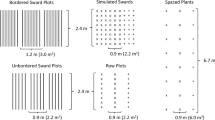Abstract
Cultivar evaluations of perennial cool-season forage grasses are an integral part of both breeding and extension programs. There is some doubt that a single trial will result in an accurate representation of cultivar means or rankings, even for a single location. The objective of this study was to quantify the additional precision and accuracy accrued in perennial cool-season forage grass cultivar evaluations resulting from collecting data on additional years of a single planting vs. repeated plantings. The study used data on forage yield, maturity, crown rust reaction (caused by Puccinia coronata Corda), and ground cover of 20 trials of orchardgrass (Dactylis glomerata L.), tall fescue (Festuca arundinacea Schreb.), timothy (Phleum pratense L.), and ryegrass [perennial (Lolium perenne L.) and intermediate (L. hybridum Hausskn.) ryegrasses and festulolium (Festulolium braunii K.A.)]. The study was conducted at Arlington, WI between 1981 and 1991. Common cultivars in pairs of trials, planted in adjacent fields in consecutive years, were analyzed by analysis of variance. Seven hypothetical cultivar evaluation schemes were created, involving various numbers of harvest years of one or two plantings made in consecutive years. Precision of each scheme was measured by the predicted standard error of a cultivar mean (SECM); accuracy was measured by the correlation between cultivar ranks of a scheme with cultivar ranks from means over all 3 years of both plantings. In most cases, there were dramatic reductions in SECM associated with use of a second planting, regardless of the number of harvest years per planting. Forage yield was the only variable for which there was almost no decrease in SECM due to additional harvest years per planting. Rank correlation coefficients for forage yield were high (r ≥ 0.86) for timothy regardless of the evaluation scheme, but increased linearly with additional harvest years for the other three species. For maturity, rust reaction, and ground cover, most rank correlations were greater than 0.9, suggesting a reasonably accurate ranking for all schemes. Because of this and the importance of forage yield per se, the accuracy and precision of forage yield is the primary consideration. An evaluation scheme of two plantings and 3 harvest years for the first planting plus 2 harvest years for the second planting was recommended for this location.
Similar content being viewed by others
References
Barker, R.E., A.W. Hovin, I.T. Carlson, P.N. Drolsom, D.A. Sleper, J.G. Ross & M.D. Casler, 1981. Genotype-environment interactions for forage yield of reed canarygrass clones. Crop Sci. 21: 567–571.
Casler, M.D., 1982. Genotype x environment interaction bias to parent-offspring regression heritability estimates. Crop Sci. 22: 540–542.
Casler, M.D., 1988. Performance of orchardgrass, smooth bromegrass, and ryegrass in binary mixtures with alfalfa. Agron. J. 80: 509–514.
Gaylor, D.W., H.L. Lucas & R.L. Anderson, 1970. Calculations of expected mean squares by the abbreviated Doolittle and square root method. Biometrics 26: 641–655.
Jefferson, P.G., R.B. Irvine & J.D. McElgunn, 1985. Harvesting irrigated alfalfa in the establishment year in southwestern Sasketchewan. Can. J. Plant Sci. 65: 323–328.
Nepal, P. & E. van Santen, 1990. Third-year forage yield testing in tall fescue is not cost effective. Agron. J. 84: 616–617.
Searle, S.R., 1971. Linear models. John Wiley & Sons, Inc. New York.
Simons, R.G.& A.T.H. Gross, 1985. Growth of four grass species as affected by rate of nitrogen application and year of establishment on two soil types. Can. J. Plant Sci. 65: 581–588.
Steel, R.G.D., J.H. Torrie & D.A. Dickey, 1996. Principles and procedures of statistics: a biometrical approach. 3rd ed. McGraw-Hill, New York.
van Santen, E. & D.A. Sleper, 1996. Orchardgrass. Pages 503–534. In: L.E. Moser et al. (Eds.), Cool-season forage grasses. American Society of Agronomy, Madison, WI.
Author information
Authors and Affiliations
Rights and permissions
About this article
Cite this article
Casler, M. Repeated measures vs. repeated plantings in perennial forage grass trials: an empirical analysis of precision and accuracy. Euphytica 105, 33–42 (1999). https://doi.org/10.1023/A:1003476313826
Issue Date:
DOI: https://doi.org/10.1023/A:1003476313826




